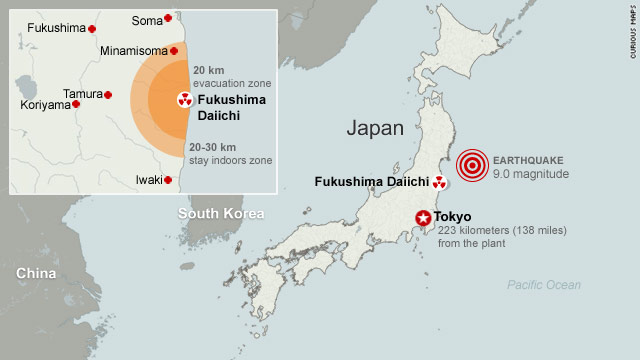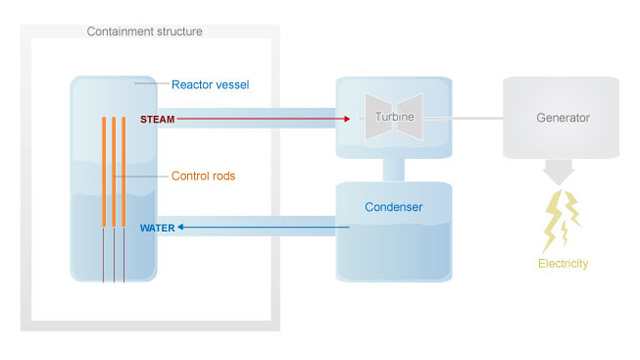Japan's nuclear safety agency said it was not immediately clear why smoke was rising from the plant's No. 2 and No. 3 reactors. Tokyo Electric Power Company said in a statement that the smoke was decreasing.
Officials temporarily evacuated workers from the plant Monday when smoke was spotted in the same area. But the agency said Tuesday that workers planned to continue efforts to restore power.
"This is going to be a two steps forward, one step back evolution," said Michael Friedlander, a former senior operator at three U.S. power plants who has been closely following the situation at the Fukushima Daiichi plant.
 Map: Fukushima Daiichi
Map: Fukushima Daiichi  CNN reporter reflects on tsunami damage
CNN reporter reflects on tsunami damage  Pouring tons of water on power plant
Pouring tons of water on power plant  TEPCO official reports on power plant
TEPCO official reports on power plant Workers have been scrambling to cool down fuel rods since a 9.0-magnitude earthquake and massive tsunami on March 11 knocked out cooling systems at the plant.
Police say the dual disaster has killed at least 9,079 people and left at least 12,645 missing, many of them killed as a wall of water rushed in following the quake.
Officials say some radiation has been released from the crippled plant since the quake and tsunami. And with the nuclear plant's six reactors in various states of disrepair, concerns have mounted over a potentially larger release of radioactive material from the facility, located about 240 kilometers (150 miles) north of Tokyo.
Officials said Tuesday that electrical cables had been laid to connect the No. 3 reactor and the neighboring No. 4 reactor with an outside power source.
That meant that power could now be funneled to all six of the plant's reactors for its cooling systems. But Tokyo Electric Power Company said Monday that electricity was still not moving to units No. 1 through No. 4 because the quake and tsunami had damaged numerous pumps and other gear. The company said spare parts were being brought in so that everything could work again.
The No. 3 reactor has been the top priority for authorities trying to contain damage to the plant and stave off a possible meltdown. Its fuel includes a small percentage of plutonium mixed with the uranium in its fuel rods, which experts say could cause more harm than regular uranium fuels in the event of a meltdown.
Hidehiko Nishiyama of Japan's Nuclear and Industrial Agency said there was no evident explosion, spike in radiation or injuries at the No. 3 reactor Monday. The smoke came from the building's southeastern side, where the reactor's spent nuclear fuel pool is located, but the origin of the smoke at either reactor was unknown.
Japan's Self-Defence Force planned to continue spraying water on the building housing the plant's No. 4 reactor Tuesday, where a spent fuel pool is also a concern.
The coolant pools contain used fuel rods that contain radioactive material and still generate high amounts of heat. Authorities have been working to keep them full to prevent the rods from being exposed and releasing radiation.
 Why spent fuel rods should matter to you
Why spent fuel rods should matter to you  Experts track fallout from Fukushima
Experts track fallout from Fukushima  Lawmaker: Japan's government doesn't lie
Lawmaker: Japan's government doesn't lie  Explainer: Producing nuclear energy
Explainer: Producing nuclear energy On the other hand, Amano told reporters, rising pressure inside the containment unit at reactor No. 3, a concern from the weekend, was down and power had been restored to some of the reactors.
Authorities said potential food contamination remains a concern.
The Japanese government has banned the sale of raw milk from Fukushima Prefecture, where the plant is located, and prohibited the sale of spinach from neighboring Ibaraki Prefecture after finding levels of radioactive iodine and cesium higher than government standards, the country's health ministry reported.
And officials in Fukushima halted the distribution of locally grown vegetables outside the prefecture.
High levels of radioactive substances have also been found in seawater near the plant, Tokyo Electric said Tuesday, adding that the results do not represent a threat to human health.
"There should be no immediate health impact. If this situation continues for a long period of time, some impact can occur," Chief Cabinet Secretary Yukio Edano told reporters.

wow very good!
Trả lờiXóa